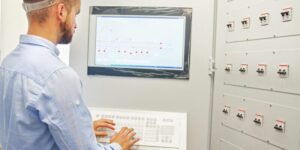
In the competitive landscape of modern production, quality is not just a checkpoint; It is a constant thread woven in very fabric of the shop floor. To achieve this level of integrated quality control requires more than manual hard work; It demands a digital nerve center that provides real -time visibility and control. This is the place where the manufacturing execution system software comes in software game, acts as a transformative layer that bridges the difference between high-level plan and ground operations. By capturing and referring to direct data from the production line, it has become an indispensable tool for manufacturers to eliminate software defects, ensure compliance and build a strong culture of quality from the ground.

The Limitations of Traditional Quality Control Methods
Traditional quality control is often operated as a reactive, silent function. Inspection usually occurs at the end of a production line or after significant operations, depending on the manual data entry on the paper checklist or separate spreadsheet. This approach creates significant gaps between being a defect and when it is discovered, potentially allows large batches of non-reuvenated product. In addition, the data collected is historical and fragmented, from which the root cause analysis is a time-elevation and often indoratoric detective game. Lack of real -time insights means that operators lack the necessary immediate response to fix a process because it deviations, causing waste, reunion and quality of the unpredictable product.
From Reactive to Proactive: The Paradigm Shift Enabled by Digital Systems
The manufacturing execution system software inspires a fundamental change in an active quality management model from a reactive. Instead of waiting for the final inspection report, the system monitors the production processes as they occur. It directly connects machines, equipment and operator terminals on the floor of the shop, causing live digital representation of the physical production process. This allows the real -time connectivity system to implement standard operating procedures, guide operators through each phase with electronic function instructions and to mark any deviation from predetermined parameters immediately. Quality is no longer inspected in the product; It is inherent in the process, in which software production serves as a vigilant patron of integrity.
Real -time data collection and process visibility
The foundation stone of better quality control is unique visibility. The manufacturing execution system software serves as a central hub, which collects a continuous stream of data from various sources. This includes machine performance metrics, sensor readings for temperature and pressure, consumption of components and human input from operator logs. This data is no longer stuck in isolated silos, but specific work is relevant against orders, batches and production lines. For an observer or quality manager, it means the ability to see the exact position of any order at any time, identifying which parameters are under control and which are trending towards a range. This transparency destroys the production process and transforms quality into an average, manageable stream from an abstract concept.

Enforcing Standardized Work and Reducing Human Error
Human error is an underlying risk in any manual process. Manufacturing execution system software reduces this risk by digitizing and implementing standardized work instructions. Instead of relying on a paper manual or operator’s memory, the system directly presents clear, step-by-step electronic instructions on the workstation. This may verify that the correct equipment is used, the correct components are scanned, and appropriate settings are applied before the process allows to proceed. In complex assembly or regulated industries, it is invaluable to ensure directed workflow stability and compliance. By reducing the capacity for variation and mistake, the system directly increases the first-pass yield and ensures that each unit is produced for the same high standard.
The Critical Role of Electronic Batch Records and Traceability
Perhaps one of the most important quality benefits of a manufacturing execution system is the automated creation of complete and accurate electronic batch records. Every action performed during the manufacturing of a batch, material lot, machine parameters and quality check is automatically logged by the system. This creates an immutable and auditable lineage for every finished product. In the event of a quality issue or a customer complaint, this granular traceability allows for lightning-fast root cause analysis and targeted recalls if necessary. A company can pinpoint exactly which batches were affected by a specific raw material or a machine that was operating outside its tolerances, reducing the scope and cost of any corrective action. This capability is especially important in industries such as pharmaceuticals and for companies implementing sophisticated food system integration solutions, where ingredient traceability from farm to fork is a non-negotiable requirement for safety and compliance.
Leveraging Statistical Process Control for Predictive Quality
With a rich historical database of production and quality data, the construction execution system software enables the use of statistical process control (SPC). The system can automatically calculate the control range and plot the real -time process data on the SPC chart. When a data point shows a trend towards a control range or a non-conversion patterns, the system can consume personnel for a possible procedure, before it results in a defect. This leads to quality control and upwards, in which the defects detecting to predict and prevention of procedure variation. It gives engineers the right to make data-driven adjustments in the construction process, refining it for optimal performance and stability.
Closing the Loop with Corrective and Preventive Actions
A strong quality system is defined not only by the ability to find problems, but also from its effectiveness in preventing their recurrence. The manufacturing performance system software formalize and accelerates the software corrective and preventive action (CAPA) process. When a non-individuality is logged into-or by an operator or by system-it can trigger a digital CAPA workflow. This provides workflow responsibilities, tracking the probe progress, and ensures that corrective action is implemented and verified to effectiveness. By closing the loop amidst the detection, analysis and resolution, the system converts different -different quality events into opportunities to improve the permanent process, promotes the culture of constant learning and refinement on the shop floor.
Enhancing Compliance and Audit Readiness
For manufacturers in regulated industries, the audit is a continuous reality. Traditionally preparation of an audit includes paper records, logs and a frantic gathering of reports – a process that is both stressful and prone to oversight. A manufacturing execution system fundamentally replaces this dynamic. Since all production and quality data are electronically stored in a centralized system, the entire history of any batch is available at the click of a button. Auditors can be provided safe access to review electronic batch records, equipment calibration logs and operator certificates without transferring through paper boxes. It not only reduces the time and cost associated with the audit, but also offers an image of a highly controlled, transparent and quality-centric organization.
Conclusion
Construction performance system represents a quantum leap for quality control over the shop floor. It crosses the limits of manual methods by providing an integrated, real -time view of production operations. By implementing standardized work, enabling complete traceability, facilitating future stating analysis and streamlining compliance, this software embeddes quality in DNA of manufacturing process. It empowers frontline workers with information that they need to excel and provide management with insight required to run continuous improvement.
Frequently asked questions (FAQs)
1. How is the manufacturing performance system software different from an ERP system in quality management?
While an Enterprise Resource Planning (ERP) system handles high-level business planning, scheduling, and finance, manufacturing exercise system focuses on real-time execution and control of production operations on the floor of the Software Shop.
2. Can this software be integrated with the current quality management system (QMS) software?
Yes, a major strength of modern manufacturing execution system software has the ability to basically integrate with a QMS. This integration creates a powerful feedback loop where quality events found on the shop floor can automatically trigger non-inflammatory reports.
3. What are the primary benefits of food system integration solutions within a manufacturing execution system?
For food and beverage manufacturers, integrating special food system integration solutions with a manufacturing execution system provides unique traceability and compliance.
4. Is the real -time data reliable from the shop floor to make important decisions?
Reliability of data is a fundamental principle of a well -applied manufacturing execution system. By automatic data collection from machines and sensors and using barcode/RFID scan for material and component tracking, the system reduces the affiliated risk of manual entry and error.
5. How does this software help reduce quality costs?
Software reduces the cost of quality by focusing on evaluation and failure cost prevention. This prevents defects from being through standardized work and real-time alert, reduces scrap and rear, speeds up the basic cause analysis to reduce downtime, and reduces administrative costs related to manual record-maping and audit preparations.


